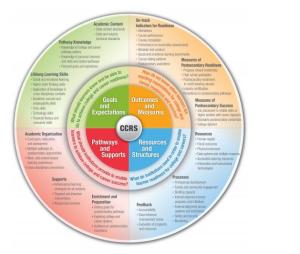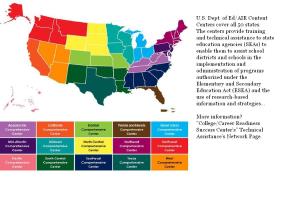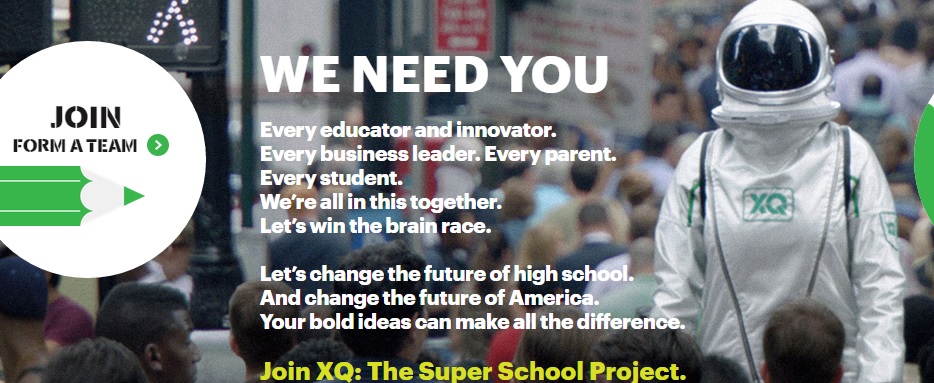
CCR, College and Career Readiness:
Hardly a new subject for me to write about, but more Common Core aligned evidence is popping up. Where did I get the above image from? A CCR Success Center!! You, too can visit their website to see just how fabulous of a job your state is doing when it comes to CCSS transitions from high school to college! http://www.ccrscenter.org/
Please first notice who houses this “Success Center”…AIR! (American Institutes for Research) A well known CCSS (Common Core State Standards) supporter, data miner! Funding, you ask? Why, the U.S. Dept. of Education, of course! Others involved ar the American Youth Policy Forum (AYPF), Forum for Youth Investment (FYI), National Association of State Directors of Career Technical Education Consortium (NASDCTEc), Quill Research Associates, LLC (QR), Achieve, Inc., American Association of Community Colleges (AACC), Campaign for High School Equity (CHSE), Change the Equation (CTEq), Collaborative for Academic, Social, and Emotional Learning (CASEL), College Board, CCSSO (Council of Chief State School Officers), IDEA Partnership (includes the U.S. Dept. of Ed’s Office of Special Education Programs), National Association of State Directors of Special Education (NASDSE), The National Center for Analysis of Longitudinal Data in Education Research (CALDER), North Carolina New Schools, SHEEO (State Higher Education Executive Officers), and Woodrow Wilson National Fellowship. To read a short description of each and to see how they have a hand in our higher education’s CCSS pot: http://www.ccrscenter.org/about-us/our-partners
Among the organization’s advisors is Dr. David Conley. I hope you took my advice from a couple of days ago and looked into his educational background, current educational philosophies and Common Core participation. You’ll be seeing his name in this post again.
Other things the “Success Center” does for our students:
Helping align our states to Common Core and create ‘success’ are what are called “Content Centers”. There are also “Regional Content Centers”. The Content Centers are run by WestED, AIR, Edvance, Temple University, and the National Institute for Early Education Research.
Regional Centers have the States divided into the color coded sections you see above. Each group is run by a select few organizations: WestED, SEDL(formerly Southwest Educational Development Laboratory), ICF International, University of Oklahoma, Educational Testing Service, AIR, Mid-Continent Research for Education and Learning, RMC Research, Education Northwest, and the Pacific Resources for Education and Learning. So just what will I find for the state I live in? Plenty! Since you all know I live in NC, the first thing I noticed is the group of states with NC are in the “Southeast Comprehensive Center”, but I see SEDL (seen above). So my first question is “Why, when I don’t live in the Southwest, is North Carolina overseen by this group?”
Guess I have to click on the Southeast Group to find out. So, I do. I see lots of vivid colors, I see a smiling face of a lovely lady..then I see below her smile, these words, “she focuses on curriculum and instruction, particularly the Common Core State Standards, effective literacy practices, early childhood education, and professional development to improve literacy outcomes in districts and schools.” This lady is considered an expert. However, there are many other experts whom I found. Each with what their areas of expertise are and how it’s devoted to the CCSS. I click on the tab with my state’s name and instantly see 10 current Common Core projects going on!! It was curious for me when I saw the words “Past Projects”, so I found the tab for that, clicked and was appalled! CCSS projects, one after another.. From 2005 to 2012! Current projects range from early childhood education, to community wide readiness, to videos for math and English. I go on to discover the Southeast Center is developing a CoP (Community of Practice) with the neighboring states also included in our Grouping. Take a look at all that will be shared: http://secc.sedl.org/resources/community_of_practice/cop_resources.php
So what are the neighboring states up to? Well, according to this SE Center, Alabama’s getting the college/career readiness standards, Georgia’s getting the Career Tech Standards, South Carolina is assessing teachers, and Mississippi is getting the little learners ready for school success. Lovely, just lovely.
What I don’t see on this particular website, is where in NC, the office is located. Hhmmm..where can I find that? By going to the other SEDL Center…Texas! Once there I see that each of the Southeast states do indeed have contact information. NC’s is out on the Coast. (hint: if you are curious, look under the ‘contacts’ on the SEDL’s main site)
More ‘successes’:
Since our original intent for Thursdays is to expose Common Core beyond high school, let’s look at other post secondary ‘college/career readiness success’ resources.
Lumina Foundation’s publication from 2013 “A Path to Alignment: Connecting K-12 and Higher Education via the Common Core and Degree Qualifications Profile”. Authors are Dr. Conley (Educational Improvement Policy) and Dr. Gaston (Kent University). According the the “Executive Summary” of the paper, ‘The heart of the white paper lies in sections 5 and 6, which provide a crosswalk between the CCSS and the DQP. These sections show how alignments and differences between the two may point to a comprehensive preparedness strategy. They also offer a proposal for a multifaceted strategy to realize
the potential synergy of the CCSS and the DQP for the benefit of high school and college educators and their students — and the nation.” Here’s the entire report: A_path_to_alignment
Achieve, Inc’s “Common Core State Standards and Career Technical Education: Bridging the Divide Between College and Career Readiness” study is also featured as a key resource. Like the Lumina publication above, the CCR Success Center wants to help you know, they are ‘all in’ to the success of Common Core alignment for your students. Now, I’ve written about this particular study before, so I know it’s loaded with tons of information you can use to inform legislators, school boards, and others who are convinced post high school CCSS is a myth.
The study was published in 2012, has the details on the CCSS/CTE/CCR teams that were formed. Here’s an excerpt from the “Executive Summary”, “Common Core State Standards & Career and Technical Education: Bridging the Divide between College and Career Readiness aims to provide guidance to state education leaders about how they can maximize the opportunity to better align academics and CTE through the implementation of the new CCSS by:
» Summarizing what state leaders are currently doing to integrate the CCSS and CTE;
» Providing specific strategies and supporting examples of what particular states are doing and
» Identifying common barriers and challenges that state leaders face.”
The study will also reveal how the Perkins Act is the main federal funding source for CTE (Career Tech Education) and how the CCSS is taking advantage of this. Here’s another excerpt you’ll find eye-opening: “To establish a reference point on the current level
of CTE involvement in CCSS implementation, Achieve and the Meeder Consulting Group
developed a survey for state CTE directors and state CCSS coordinators to take collectively. The survey was implemented during a two-week window in November 2011. Drawing from the survey findings, eight states were selected for more in-depth interviews: California, Illinois, Kentucky, Mississippi, Missouri, New Jersey, Ohio and Oregon.
The purpose of the survey was to determine how state education agencies are including CTE leaders as stakeholders or partners in their CCSS implementation efforts.”
You’ll especially like that the study includes CCSS being written into CTE curriculum (see page 13, where Chapter 4 begins). Page 19 shares how CCSS/CTE align teachers were brought into the mix. Chapter 8, begins on page 22, and expressly details the alignment of post secondary education with Common Core, “To represent true college and career readiness, postsecondary administrators and faculty from the core academic disciplines and technical areas should be aware of and involved in implementation of the CCSS. Postsecondary CTE faculty can provide information about the kinds of literacy and
math skills that will be necessary for students to succeed in their postsecondary CTE programs. Technical colleges are particularly important in these efforts given their role in delivering CTE at the postsecondary level. If secondary CTE educators are reluctant to embrace the CCSS, then this kind of input from postsecondary CTE faculty can reinforce the case for strengthening literacy and math in CTE programs.” See the rest: http://www.achieve.org/files/CCSS-CTE-BridgingtheDivide.pdf
A video:
From the CCR Success Center’s You Tube Channel (where you’ll find several CCSS/CCR/CTE webinars), here’s the one from the National High School Center back in 2013.
[youtube https://www.youtube.com/watch?v=CmTZNPXAaAg&w=420&h=315]
Closing:
I hope you have really found some very useful information in the last 3 posts. Each one has involved SHEEO, CCSSO, AIR, and the U.S. Dept. of Ed. The articles have been designed to be a one, two, and three punch in the face of the CCSS Machine. If you like, think of it in the ‘3 Strikes’ analogy. However you think about it, realize because each of these Three posts, ALL educational choices are involved. How? Because no matter what choice you’ve made for education in preK to 12th, we all have post secondary opportunities that are either publicly or privately funded. Some use both types of funding. It is becoming almost impossible to find a post secondary school NOT embracing either Common Core, Career Tech Common Core, College/Career Readiness or a combination of any of these. Remember, STEM is also woven into this mix, so the net that’s been cast over a our nation, has certainly gotten even wider than we first knew.


3 thoughts on “Tech Thursday: College/Career Readiness Success and Common Core”